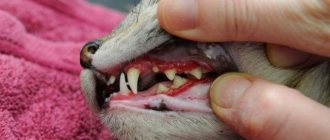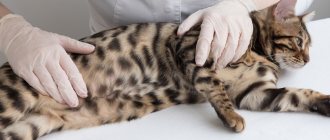Dermatitis is an inflammation of the deep layers of the skin. It is not an independent disease; rather, it is a symptom of some pathological process occurring in the body. According to statistics, one of the most common reasons for visiting a veterinary clinic is dermatitis in cats.
It does not pose any threat to human life, but it can cause a lot of suffering to a pet, manifesting itself in the form of severe itching, skin rashes and other painful symptoms.
Causes of the disease
The interaction of the irritant with the animal’s body leads to the body’s production of an antigen, which, when it enters the connective tissues, stimulates increased release of histamine. Since the concentration of such cells is contained in the skin, it instantly reacts to the “aggressor” substance, causing an inflammatory process.
Based on the reasons that caused the irritation, several types of dermatitis are distinguished:
- Infectious (bacterial). It is formed as a result of damage to the dermis and the penetration of harmful microorganisms into its cells.
- Flea. Appears due to an allergic reaction of the body to the saliva of insects (fleas, lice eaters, subcutaneous mites) when bitten.
- Allergic. Caused by external irritants, food, feed.
- Atopic. Caused by a genetic predisposition to the disease.
- Contact. Occurs when interacting with chemicals.
- Traumatic. It is a consequence of scratches, injuries, cuts and even friction of the collar.
- Drug dermatitis. They are caused by certain medications, most often antibiotics.
- Surface. Formed as a result of hypothermia and burns.
Other causes of skin pathology include internal diseases and hormonal disorders. In addition, there are often cases when dermatitis in cats is diagnosed as a result of stress, which can be caused by anything - a change of owner, a noisy company in the house, a visit to the clinic.
Symptoms of illness can appear in both a kitten and an older cat. Not a single animal is immune from this unpleasant phenomenon, regardless of gender and breed.
Subcutaneous mites
Demodex
Most often, the appearance of crusts is associated with the activity of subcutaneous mites Demodex and Notoedrus. Parasites live in different layers of the skin, causing itching, scratching, the addition of microflora, the release of ichor from the capillaries, drying out and the formation of crusts. Both types of mites crawl onto the surface of the skin. Notoedrus move on to a new victim and do not disdain humans. They stay on it longer than Heyletiella, but cannot reproduce. Children, old people, and people with immunodeficiency suffer.
Be sure to read:
What to do if a cat licks its fur to bald spots and wounds, what is overgrooming
Feline Demodex do not infest the owner's skin, probably because they cannot compete with human mites. It should be noted that cats and ticks can coexist peacefully for years, and the disease occurs when the immune system weakens.
Mites are destroyed by applying insecto-acaricidal external preparations to the damaged surface. 4-5 treatments are required at intervals of 5-7 days until the pathological symptoms disappear. Prevention of the disease is the same as for fleas and skin mites.
Clinical manifestations
With parasitic dermatitis, the four-legged pet becomes nervous, refuses to eat, and suffers from incessant itching around the ears and tail. He constantly itches, licks himself and even bites himself. The skin becomes covered with rashes, red spots, and peels. Weeping sores and crusts form on the back, neck, chest and behind the ears. Fleas and lice eaters can be identified during an external examination.
If the dermatitis was caused by a subcutaneous mite, then skin lesions are also observed on the limbs and eyelids. It is not possible to detect the parasite with the naked eye.
The cat's appearance deteriorates. The coat loses its shine, becomes dry, brittle, and alopecia is possible.
Allergic dermatitis is characterized by the appearance of blisters, pustules, swelling, and redness of the skin, especially in the abdomen and groin area. When touching the inflamed areas, the animal experiences pain.
Histamine, which the body produces in response to the allergenic component, causes severe itching. The cat is continuously coughing and sneezing. The eyes become red and watery.
Atopic dermatitis occurs in cats between 10 months and 3 years of age. Allergens include plant pollen, dust, components contained in perfume compositions, and much more.
The inflammatory reaction in contact dermatitis is localized in the place where the skin comes into contact with a dangerous substance. Various acids, alkalis, pastes, and creams can act as the “aggressor”. The cat is bothered by itching on the paw pads, in the abdomen, neck, chin, and anus.
Purulent dermatitis is characterized by a chronic course. According to the clinical symptoms of the inflammatory process, it can be wet and dry. In the first case, erosions form on the damaged skin, in the second - scabs and crusts.
Superficial dermatitis manifests itself in the form of small redness and, as a rule, goes away on its own.
The procedure for making a diagnosis for skin problems in a cat
The veterinarian begins the appointment from afar - asks the owner about the conditions of the pet’s keeping, about nutrition, about changes in behavior. Only after this the specialist examines the animal. First, the doctor assesses the general condition of the skin and coat and pays attention to the location of the problem. So, scratching near the ears of a cat may indicate that the problem lies inside the ear. Severe itching is caused by otodectosis - ear scabies.
If lichen is suspected, Wood's lamp diagnostics is used. The skin and fur are examined under ultraviolet light in a completely dark room. Some fungal colonies will glow bright green. Even if there is no glow, a dermatologist can take a culture for the fungus.
Deep skin scrapings and microscopy are needed to detect subcutaneous microscopic mites in sarcoptic mange. But again, a negative scraping is not a sufficient basis to exclude the diagnosis.
In general, diagnosis in dermatology is complicated precisely because most diagnoses are confirmed empirically - the response to therapy is assessed. Some external parasites can be seen upon careful examination - haietiella, lice-eaters, fleas. But most often it is not possible to detect fleas. 90% of the flea population does not live on an animal, but is found in the environment. Those fleas that are on a cat cleverly hide in the thick undercoat and are often swallowed by licking and biting.
The dermatologist usually tells you how to treat your cat's scratching, and then begins to rule out the causes of itching one by one, starting with the most obvious ones. And the first recommendation is always treatment for fleas and other external parasites for at least three months.
Diagnostics in a veterinary clinic
To identify dermatitis, veterinary clinics use complex diagnostics. This is due to the variety of causes that cause this skin pathology. At the initial stage, the veterinarian conducts a visual examination of the cat, collects an anamnesis, which includes information about the nature of the diet, information about the pedigree.
Mandatory diagnostic tests include:
- bacterial culture and microscopic examination of skin scrapings (detection of subcutaneous mites, fungal infections);
- trichoscopy (if the vet suspects ringworm);
- urine tests;
- blood tests for leukocytes and eosinophils;
- determining the sensitivity of bacteria to antibiotic drugs.
After making a diagnosis, the veterinarian develops an individual treatment regimen, including a comprehensive effect on the disease. Therapy is aimed at eliminating the cause of the pathology.
Lichen
Ringworm is a disease in which the skin becomes covered with an itchy rash, hair falls out, and crusts form.
The following types of lichen, characterized by the appearance of crusts on the back, are common to cats and people:
- Shearer.
- Pink.
- Red flat.
Ringworm
Ringworm
The disease is caused by micromycetes Microsporum and, less commonly, Trichophyton. Initially, single patches of baldness appear, which gradually grow and cover the entire body. The skin peels off, breaks down, ichor leaks out, and crusts form. Kittens and pets with weakened immune systems get sick. Veterinary care will be required to eliminate pathological signs.
External wound healing ointments and gels are used. For large-scale lesions, Imaverol is effective. Treatment consists of bathing the animal four times at three-day intervals.
Imaverol
To speed up recovery, medicated food is used for cats with skin diseases. Prevention consists of complying with standards for keeping and feeding professional food of at least premium class. Vaccines against fungal diseases have been developed, however, felinologists do not risk using them due to frequent complications.
Pityriasis rosea
The causative agent of the disease is a virus. The disease is inherited. Pink itchy spots cover the entire body. The pathogenesis is the same as for ringworm. Pathological symptoms occur when the immune system is weakened. Children, the elderly, and people with immunodeficiency are isolated from a sick cat.
Treatment is prescribed by a veterinarian. They use antihistamines, external agents, and immunostimulants. Exclude natural food and dry food. Use wet medicinal canned food. The duration of therapy is determined by the veterinarian.
Be sure to read:
A cat's hair is falling out: reasons, what to do during shedding, treatment of baldness, approved medications
Treatment method and prognosis
The sooner the fight against dermatitis is started, the higher the chances of successful recovery. Ideally, therapy is carried out without waiting for the inflamed skin to harden and become thicker. This means that the disease has become chronic and will be more difficult to cope with. The main type of drug therapy is anti-itch drugs. The following means are used:
- Antihistamines (Fenistil, Tavegil, Clarotadine) - subcutaneously, orally. The active ingredient is hydrocortisone. Most effective for allergic dermatitis, but prohibited for infection.
- Stop Itching ointment is a complex product with anti-inflammatory, antipruritic and antibacterial properties.
- Medicines containing aluminum. Alusprey gives good results, accelerating the regeneration of damaged tissues and having an antiseptic and anti-inflammatory effect.
In case of traumatic dermatitis, the necessary measure is to treat the affected areas of the skin (abrasions, scratches, etc.) with an alcohol solution of iodine. You can use compresses with Vishnevsky ointment, lotions with disinfecting and astringent components.
Veterinarians warn: frequent use of highly irritating compounds and alcohol solutions can provoke drug-induced dermatitis. When it occurs, you need to use emollient and disinfectant ointments, such as Solcoseryl, salicylic-zinc, syntomycin. Creams based on propolis give a good effect.
If traumatic dermatitis turns into bacterial, then the infected area is treated with chlorhexidine and covered with antibiotic powder on top. The wool is pre-cut, exudate and dried crusts are removed. If the animal is in serious condition, accompanied by lack of appetite, lethargy, and high fever, antibiotic therapy in the form of injections cannot be avoided. The task is to prevent the introduction of a secondary infection into the process and stop purulent complications.
For infectious dermatitis, which is caused by pathogenic fungi, antifungal agents, antibiotics, as well as anti-inflammatory drugs Prednisolone, Dexamethasone are used.
If exposed to harmful substances that cause chemical dermatitis, it is necessary to rinse the skin with cold water. Rinsing should be carried out for at least 10 minutes, using a good jet pressure. Next, the substance itself should be neutralized, for which the affected areas are treated with a weak vinegar solution. Alternatively, you can use citric acid, baking soda.
If a cat suffers from allergic dermatitis, then it is transferred to a hypoallergenic therapeutic diet prescribed by a veterinarian. Modern manufacturers of cat food offer a wide selection of specialized premium and super-premium food that can solve this problem.
As for superficial dermatitis, if it does not go away on its own, then the area of skin that has been exposed to frostbite or burns should be sprayed with a special spray.
To eliminate the possibility of scratching and, accordingly, injury to the skin, it is advisable to use a medical bandage or a protective collar, which should be fixed on the cat’s neck.
Among other things, it is necessary to strengthen the pet’s immune system, for which an obligatory stage of therapy is the use of immunostimulants. As a rule, veterinarians recommend Immunol Vet, Gamavit, Glycopin, Gamapren.
You also need to treat your pet against insects using antiparasitic agents.
The specialist must monitor the treatment process in order to make adjustments if necessary - change the medication, dosage.
As for the prognosis, if therapy is started in a timely manner, it is favorable.
Possible complications include the transition of dermatitis to a chronic form, weakening of the immune system, which makes the pet vulnerable to various diseases. Allergic dermatitis, which occurs as a result of a reaction to an irritating substance, is considered the most dangerous for cats. The lack of medical assistance is fraught with the development of Quincke's edema, which leads to death from suffocation.
Eczema
Weeping eczema
Eczema is a skin disease of the deep and superficial layers. There are dry (chronic) and weeping (acute) forms. In both cases, the purulent exudate dries out and forms crusts.
There are the following causes for the development of eczema:
- Traumatic . Occurs as a result of damage from accessories that rub the skin, burns, frostbite, and arthropod bites. It occurs in a wet form, and after eliminating the causes of the disease, rapid recovery occurs.
- Neuropathic eczema. A congenital anomaly characterized by bilateral dermatitis. It worsens under the influence of stress factors. It is incurable and requires lifelong use of symptomatic medications.
- Reflex eczema. Occurs under the influence of allergens in the saliva of arthropods and contact irritants. Symptoms, treatment and prevention are described above.
- Internal factors. The skin reacts to pathological signals coming from affected internal organs. Clinical manifestations disappear when the underlying disease is eliminated. To speed up recovery, wound-healing external agents and medicated food are used for cats with skin diseases.
First aid
The owner must provide the pet suffering from dermatitis with the most comfortable conditions and strictly follow all the veterinarian’s recommendations. Self-medication will cause irreparable harm to health, because the allergen that provoked the disease may well be hidden in the home medicine cabinet. Under no circumstances should you independently select or change medications prescribed by a veterinarian, or reduce or increase the dosage!
As first aid, you can give your four-legged pet the “Stop Itching” suspension to weaken the effect of the irritant. You should not smear the affected areas of the skin with anything, as this will significantly complicate the diagnosis in a veterinary clinic.
To prevent your cat from picking at sores, lightly file his claws and put on a light blanket to prevent infection from entering the wounds.
Swelling of the paws indicates that the dermatitis is most likely caused by an allergy to cat litter. In this case, you need to replace the contents of the tray, choosing a composition without small particles and odorless.
What actions should I take?
Sores on the back along the cat’s spine (as well as in other places) cannot be ignored. The animal needs help. It all depends on the reason.
If the owner is sure that the cat is being attacked by parasites, and the sores are caused precisely by their bites, the animal should be treated for fleas. Today there are enough products on sale that will help quickly solve the problem. The wounds themselves can be treated with an antiseptic to prevent infection and speed up the healing process.
If you suspect that skin problems are the result of an allergy, you can try to review your pet's diet. However, it is not always possible to guess which product caused the reaction, and time passes, and the cat needs to be treated. Therefore, it is better not to take risks, but to immediately show the animal to a veterinarian. He will take tests, determine the irritant and tell you how to deal with the cause of the sore.
This also applies to other situations where the lesion on the back is similar to lichen or demodicosis. You should not engage in amateur activities. Professional diagnosis is required, and then serious treatment . It often involves taking antifungal, anti-inflammatory, and antibacterial drugs.
Only competent advice from a specialist, complex therapy and the caring hands of the owner can quickly alleviate the cat’s condition and eliminate sores without consequences.
What to do if your cat has back pain
Author: Elena(admin) March 2, 2017
The crusts can be described as pustules, or small, hard, red nodules. Their number can vary from one to several dozen. The type of sore, location, and accompanying symptoms can help your veterinarian determine the cause. Sores on your cat's neck and back (especially close to the tail) may indicate hypersensitivity to flea bites. Sores around your cat's head and ears may be due to food allergies. Sores on a cat's chin are usually caused by acne. Seasonal itching, accompanied by scratching and dry sores, indicates an allergy.
Hypersensitivity to flea bites
The most common cause of sores in cats is hypersensitivity to flea bites. Cat fleas are wingless parasites; adult fleas live on the cat's body, feeding on its blood. Many cats develop an allergy to flea saliva, whose bites cause a localized reaction. Small sores can be found at the base of the cat's tail, around the neck and on the chin (see photo). The size of scabs varies in diameter from 3 mm to 1 cm or more. Excessive scratching can cause the sores to bleed.
Non-parasitic
Non-parasitic diseases include skin lesions such as acne, eczema and bedsores. The difference between non-parasitic infections and parasitic ones is that they are not transmitted to humans or other animals and arise solely as a result of exposure to external irritants.
Acne
This is a bacterial inflammation of the sebaceous glands. The reason for this is a weak immune response. The main symptom is purulent pimples or blackheads located throughout the animal’s body. Treatment consists of using tar soap or anti-dandruff shampoo, and then treating the affected areas with antiseptics such as Miramistin. Sometimes the use of local antibiotics (Mupirocin) is required.
Eczema
It most often occurs in cats with very sensitive skin. The reasons are various injuries and damage to the skin, hormonal imbalances.
Typical symptoms include:
- rash;
- severe itching;
- irritation;
- blisters on the body;
- increased body temperature.
Over time, the wounds begin to peel off and then turn into weeping, purulent wounds.
Treatment consists of using soothing ointments, creams, gels and powders (Vishnevsky ointment, zinc ointment, Lassar ointment). Antiseptics should be used before applying the ointment. In advanced cases, the use of antibiotics may be required.
Bedsores
Appear after a long period of lying and immobility of the animal. Often affects pets in the postoperative period or paralyzed cats. It appears in those places that are in direct contact with the surface. It is important to follow preventive measures (lubricate parts of the body touching the surface with camphor alcohol). Levomekol ointment is used for treatment.











